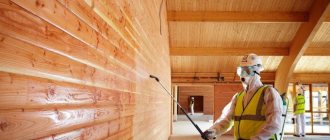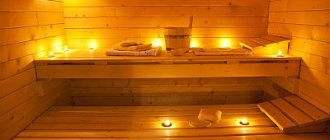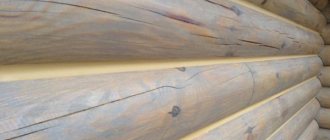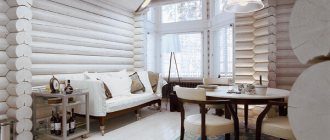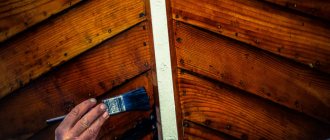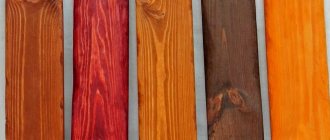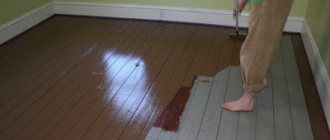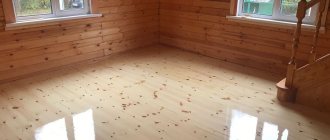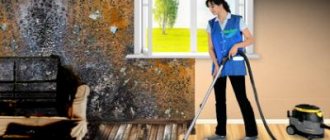The ends are the most vulnerable areas of the logs, since the wood fibers remain completely open and are more exposed to the negative effects of weather factors than other areas. The processes of moistening and rapid evaporation of moisture lead to the formation of cracks at the ends, as a result the logs can crack, which has a very bad effect on the strength of the wooden structure. Treating the ends of rounded log logs with special antiseptic agents will help prevent the development of negative processes. If protective treatment is carried out in a timely manner, the wood dries evenly, which has a positive effect on the appearance of the logs and the log house as a whole.
Why process the ends of logs?
The need to treat the ends becomes obvious if you look at an untreated log that has lain on the street for several years, the ends of which have lost their natural color and darkened, become covered with cracks, and fungus and mold have appeared on them.
This happens because the open ends actively absorb moisture, which then quickly evaporates, and the loose wood structure becomes a refuge for microorganisms and insects.
Moisture evaporates through the end and side surfaces of logs at different rates. Evaporation of moisture through the ends occurs much faster, which leads to the formation of cracks and deformation of the crowns.
Painting the ends of the log house promotes uniform drying of the logs, since the rate of evaporation through the painted surface slows down, and accordingly, the process of cracking stops.
Valuable tips for painting a log bathhouse
Let's summarize: the main goal of modern paints for timber is to protect wood from blue stains, mold, UV rays and any other atmospheric phenomena. But in order for the protective coating of the timber to do its job 100%, you must do everything correctly.
Tip #1. Paint the sauna frame yourself
If you paint a log house yourself, you will gain a lot of advantages. After all, it is quite difficult to judge the quality of the team’s work only by the appearance of the bathhouse, and their main task is to create a finished beautiful object. And, unfortunately, workers often leave unnoticeable small gaps in the processing of the log house from the outside. Over time, these places become a source of problems such as rot, mold and destruction of the walls of the bathhouse from the inside.
Tip #2. Properly prepare the log house for painting
First of all, it is important to properly prepare the surface of the log house for painting. To do this, you need to remove all dust and foreign debris.
It is advisable to rinse the bathhouse walls thoroughly with water using a hose and a stiff brush. Then dry well. If necessary, sometimes it makes sense to carry out serious grinding:
If you notice any lesions at this stage, treat them with Woodmaster Frost Whitening Solution. And for cracks and small defects Eurotex is more suitable.
Advice: if you notice traces of mold on the logs of a new bathhouse, it is advisable to consult a mycologist before painting: it is still “harmless” mold or a real destroyer.
In addition to standard cleaning and sanding of the log house, you need to take care of its protection. If you are not sure of the quality of the delivered timber, do not make do with a standard antiseptic - it is better to use Language, which kills all spores. And as a topcoat, choose a Fungicide, which will help prevent the appearance of algae and mold on the surface. In extreme cases, you need to clean the walls well and apply a clear coat of Log washadvance.
Tip #3. Paint the ends with lime or a modern equivalent
This is done in order to force water vapor to move along the log and escape through the ends. This is a natural process that occurs due to the difference in temperature indoors and outdoors, and here the steam room is at particular risk.
If in this case the park runs along the fibers, and not across, this is how moisture moves in a growing tree, well, what should you do if you have to.
Tip #4. Don't leave any gaps
During the process of painting a bathhouse, it is important to ensure that there are no unprotected gaps, which can easily cause many problems. Therefore, add a signal color to a colorless antiseptic, and then leave it to dry for 3 days during a period without rain, so that the active substances are fixed in the wood and the effect is achieved
Tip #5. Choose the most beautiful paint!
Modern manufacturers offer not only compositions that simply paint over the substrate and hide the natural grain of the wood. Today, decorative protective and decorative texture paints for log baths are in fashion, which not only preserve the wood from atmospheric agents, but emphasize its beautiful texture!
And it has additional valuable features. For example, today the following texture paints for Russian log baths are especially in fashion:
- “Favorite Dacha” is an economy-class paint to protect the log house from blue stains, ultraviolet rays, and fungus - and all this without a primer.
- “Aquatex” is a paint with an antiseptic and a modern ultraviolet filter. On the surface of the walls of a log bathhouse, it creates a semi-matte elastic coating, and also without priming. Moreover, it can be applied even to damp wood.
- The “Aquatex Extra” variety is a protective coating, an elastic coating made of natural oil and microfiber. This paint has ultraviolet protection in two ranges.
- In order to paint an old bathhouse, Aquatex Restorer paint is more suitable for you: you will be very surprised by the result.
The appearance of the bathhouse should please the eye and warm the soul!
Based on the article https://cdelayremont.ru/banya-svoimi-rukami
Requirements for protective equipment
The first processing of the ends must be carried out immediately after the construction of the log house.
But since in the first years after construction there is an active process of shrinkage of the log house, it is necessary to treat the ends with a product that does not interfere with the natural shrinkage processes occurring in the wood. An antiseptic for the ends of a log house must have the following characteristics:
- do not interfere with the evaporation of moisture from the logs through the ends along the longitudinal fibers;
- do not suppress the processes of moisture removal through transverse fibers;
- do not interfere with the removal of moisture from the surface.
- protect wood from exposure to ultraviolet radiation;
- prevent rotting processes.
How to treat the ends of logs?
The traditional end treatment is lime.
It is still often used for these purposes today. Lime is a natural antiseptic that protects wood from rotting and UV rays. However, the period of action of this product is very short, since the first rain will completely wash away the lime, and the ends will be left without protection. Knowing this, many owners of wooden houses use PVA glue or acrylic varnish to process the ends. But the effectiveness of these products is also questionable, since they form a film on the surface that prevents the evaporation of moisture and interferes with the full air exchange of the wood.
How to paint the ends of rounded logs to ensure their effective protection? Currently, Russian and foreign manufacturers produce a lot of impregnations for processing ends. Among domestic antiseptics, three products are recognized as the best:
- Senezh Tor.
- Neomid Thor Plus.
- Biotor.
Senezh Tor
The product has good penetrating ability.
The antiseptic is absorbed into the wood to a depth of several centimeters, forming a protective layer on the surface that allows air to pass through and repels water. The coating helps remove excess moisture from the wood, prevents the development of putrefactive processes, and reduces the depth and number of end cracks. The antiseptic does not lose its protective properties for several years. The product does not contain solvents and does not emit odor, tolerates frost well and has fire retardant properties. For ease of application and control of treated areas, the antiseptic slightly changes the color of the wood.
Neomid Thor Plus
The product protects the ends from biological damage by microorganisms and insects, prevents the formation of fungus and mold and prevents rotting.
The antiseptic creates an elastic protective film on the ends of the logs that does not allow moisture to pass through, which prevents the accumulation of excess moisture in the wood fibers. At the same time, the coating is vapor permeable, so it does not interfere with the air exchange processes occurring in the wood.
Painting the ends of logs with this product does not in any way affect the aesthetic characteristics of the log house, since the antiseptic preserves the natural color and texture of the wood.
Biotor
It has similar characteristics as the products listed above. Impregnation protects the ends of logs and beams, creating a waterproof transparent coating on the surface that prevents rotting and cracking of the ends, and also reduces existing cracks. The elastic film also helps reduce the linear deformation of wood that occurs during shrinkage.
Why is there such attention to the ends of the log house?
The ends of the log house have a small area relative to the rest of the wood area. So why should you pay special attention to the ends?
Processing of the ends of the log house should be carried out immediately upon completion of the assembly of the structure. If you delay this, the results can be very disastrous.
Moisture penetration
The thing is that on the cross section, namely at the ends of the frame, in this case, the wood fibers are completely open. In this regard, any amount of moisture easily penetrates deep into the wood. Which will ultimately cause rot, mold and mildew. The wood at the ends begins to darken.
Wood cracking
Another undesirable consequence of not treating the ends of the frame will be cracking of the wood. Logs dry out unevenly along their length. Since the ends are open, moisture evaporates from them most actively. That is, the edges of the log become dry, but there is still a lot of moisture present in the center of the log.
As a rule, all this leads to cracking and changes in the geometry of the log. If the ends of the logs are processed, the moisture will evaporate more evenly. Along the edges and center of the log.
Decorative properties
In addition, processing the ends of the log house is necessary to protect the building. Both from external influences and to avoid cracking and warping of the log. The finishing of the ends of the log house also has a decorative role. Treated ends look much better than untreated ones.
Processing technology
To provide a wooden house or bathhouse with good and durable protection, it is necessary to adhere to a certain order of work.
Before treating the ends with an antiseptic, it is necessary to perform a number of mandatory operations. The work is performed in the following sequence:
- Trimming of a log house. This operation involves cutting off the protruding parts of the logs. During the construction of a house from otsb, the size of the logs is not regulated. After construction, the length of the logs in the cuts is rarely the same, and the ends, as a rule, are also not perfectly even. The formation of a neat and even vertical plane is done after construction. The protruding ends are cut off with an electric or chainsaw.
- Next, the ends of the frame are polished. Using grinding, the surface is prepared for antiseptic treatment. After sanding, the absorbency of the wood increases, the ends will absorb the antiseptic better and more deeply, which will ultimately increase the period of action of the protective treatment.
At the first stage, rough surface treatment is performed using a grinder with coarse abrasive. Then the ends are sanded with a finer sanding attachment. Processing must be carried out until a layer of undamaged and clean wood appears.
Grinding the ends of a log frame made of rounded logs can only be done in dry weather. You can only process completely dried logs, the humidity of which does not exceed 20%. When sanding wet wood, fluff is formed, which prevents the surface from being smooth and even.
- Protective treatment of ends with antiseptic. The ends are treated with a wide brush at least three times. Impregnation is applied in a generous layer. After the first layer has completely dried (about a day), apply the second, and then after 24 hours the third layer.
- Sealant treatment. This operation is performed after antiseptic treatment to create a durable moisture-repellent coating on the ends that prevents excessive moisture in the wood. For these purposes, it is recommended to use special acrylic sealants.
Years of experience or modern technology?
In the new millennium, humanity has become especially concerned about the environmental friendliness of its life, remembering the wisdom of centuries and the traditions of its people. So, the bathhouse has become such an outlet for the Russian people: now almost every second summer resident is trying to build at least a small, but his own steam room. What can I say: the richest landscape designs decorate Russian-style log baths. But just as the filling of such a steam room has changed over time, so have some of the nuances of its construction.
What if you leave it without painting?
Today, many bathhouse attendants leave the walls of bathhouse logs open from the inside and outside, asking the already rhetorical question: why build a bathhouse from an environmentally friendly material, “living and breathing” wood, and then cover it with “chemical film”, aluminum foil and “poisonous” impregnations" from the street side? Therefore, the most ardent adherents of the “true steam room” do not use either vapor barrier or paint, as was done in Rus' throughout the centuries.
When the baths were heated, the log house, like a sponge, absorbed moisture and gave it away just as easily. Of course, such baths lasted no more than 5-10 years, because... became too dry and not fireproof. And already on the site of their ashes, a strong new steam room was built, which was quite a common thing.
You will be surprised, but this practice still exists! True, there is one “but”: you will have to heat a truly Russian bathhouse with the same Russian stove in black style. Because only the smoke from it, which quickly smoked the new bathhouse from the inside, is capable of disinfecting its walls from the ubiquitous fungus.
Why isn't any paint or varnish suitable?
Let's give a good example. The modern market is simply replete with materials for finishing timber outside: both in the method of action and in color and texture. But even relatively recently, in Soviet times, most wooden buildings were covered with ordinary oil paint. Cheap and cheerful, as they say, and a rich palette of shades.
Therefore, many novice bath attendants today think: why spend money on more expensive paint if you can use the same oil paint? The trouble is that the wood under such paint does not breathe, and the water vapor from the steam room remains in the walls. As a result, wood insects, mold and rot easily grow in such a log house. As a result, a completely new bathhouse has a grayish coating on top of its spectacular shade, not to mention the internal destruction of the walls themselves.
After all, even those modern baths, which are covered from the inside with a whole cake of moisture and vapor barriers, cannot be 100% protected from water vapor. Look at the numbers indicated by manufacturers of conventional vapor barrier films, which retain water vapor by only 75-80%. And even expensive membranes do their job only 95-97%
Therefore, it is extremely important that the paint or impregnation for timber is universal and performs all its important functions
See why not all substances are suitable for treating wooden bath walls:
End processing after shrinkage
After the initial shrinkage of the log house, approximately 12 months after construction, the ends are painted with a product that creates a durable protective film on the surface. This can be either drying oil or paint containing oil or wax.
Antiseptic treatment is necessary in any case, even if in the future it is planned to finish the ends of the log house with siding, clapboard or other decorative building materials.
will process the ends of the log house at a high professional level. We have been specializing in finishing wooden houses and baths for more than ten years, so we guarantee excellent quality of processing. All work will be completed exactly on time specified in the contract.
To discuss all working conditions in more detail, contact us using the coordinates in the “Contacts” section.
Calculate the cost of painting and insulating your home right now
Select types of work:
Select materials:
The process of applying antiseptics and primers to sanded walls
After sanding the walls of the house, you need to treat them both inside and outside. The work is complex and requires material investments. Not everyone has the patience to finish it to the end.
Before applying the main layers, you should pay attention to the caulking of the log house walls. If cracks appear, re-caulk
To seal cracks, special sealants are produced that cover the caulk and protect it from the harmful effects of the environment. If the caulking was made with natural flax fiber, then it is necessary to protect it from moisture. You can use, for example, Neomid or Remmins sealants. Only after complete caulking around the entire perimeter and its processing can you begin painting the walls.
End finishing
When processing the surface of the log house walls after grinding, you should pay special attention to the ends of the log or timber. Wood capillaries are located from top to bottom for better penetration of liquid to the crown
When sawing, these channels are exposed, and moisture from the environment easily enters them. If you treat the ends with a simple sealant or antiseptic, this will not bring the desired result. This means that over time the walls will crack and darken. Finnish manufacturers recommend using acrylic moisture-resistant product TEKNOL JRM. After such painting, the permeability of moisture into the ends is reduced by 15-20 times. This product costs from 350 rubles/3 liters.
Liquid glass treatment works in a similar way, but it contains toxic substances. But it is cheap.
Any of the selected products should be applied in two layers, carefully covering all joints. Before applying the second, the first is allowed to dry.
Wall treatment
The walls are treated in the warm season at above-zero temperatures, immediately after sanding and caulking, immediately after the construction of a house made of profiled timber is completed. Grinding is best done using a grinding tool with a P80 disc. After this, the dust is removed from the logs and the first layer of antiseptic is applied, for example colorless Teknol Aqua 1410-01. Painting should be done with a brush or electric spray gun. The primer is applied in two layers.
The next step is to process the walls again using a sanding machine with P220 or 240 discs. After applying the primer, hairiness appears, which is better to remove. Sanding will take a long time and requires expensive and powerful equipment. So a high-quality grinding machine costs from 2,000 rubles. And with high power, sanding a 30 cm wall takes about half an hour. Of course, you can skip this step, since it does not affect the protective characteristics.
The next step is painting with glazing compounds. You can use a covering antiseptic. The compositions must be applied in the same way, using a brush or spray bottle.
To save money, instead of glazing compounds, you can use simple acrylic paint for facades. But the wood texture will be hidden. For example, acrylic paint for Tikkuril facades tolerates temperature changes well and has many shades and colors. The cost of this product is from 1,500 per 10 liters.
With high-quality processing and caulking, wooden walls will serve the owners for more than 50 years. But painting should be done at least once every 3-4 years. It's nice to be in a wooden house that not only looks good, but also breathes. And this can be achieved only by painting the external walls after sanding with natural and high-quality materials.
